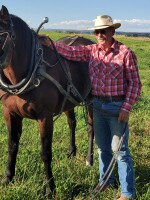As we look at the U.S. agricultural economy, it’s apparent that livestock producers are much more optimistic about the prospects for the near term then crop producers. Beef producers see the potential for record profitability this year. But crop producers are likely to have a tougher time. Over the Past couple of months, the Purdue University-CME Group Ag Economy Barometer Index has registered falling optimism among crop farmers concerning future prospects for their operations due to the expectations that returns on their crops will be low. Also, agricultural economists and agricultural lenders have begun to register concerns that all is not well in the agricultural economy. They’re finding troubling comparisons to the 1980’s farm financial debt crisis that caused many farmers to file for bankruptcy, often forcing them out of farming. Small rural communities were also casualties of the downturn in the ag economy. The stage for this debt crisis was set in the late 1970s, when the Nixon Administration’s Secretary of Agriculture, Earl Butz exhorted farmers to plant fence to fence row in order to provide crop exports to the Soviet Union. So progressive farmers bought into Butz’s advice, going into debt to expand their operations by buying larger machinery and more land, often using the land they owned free and clear as collateral for these loans. But their plans began falling apart when President Jimmy Carter enacted a grain embargo on the Soviet Union, because they invaded Afghanistan in 1980. The lack of other export markets caused U.S. crop prices to tank, while high inflation rates made it almost impossible for farmers to pay down their debts. Many progressive farmers had borrowed against their land to expand their operations, so by 1981, these farmers found themselves in tough financial binds, because crop prices had declined, while interest rates had gone up. By 1982, in many rural communities, farm liquidation sales were almost weekly events. Families left communities to begin a new life where they could find work, and some rural communities have still not recovered from that catastrophe.
Fast forward to the present. Although we have some similarities to the 1980s, not all sectors of the ag economy are at risk. While many crop producers are facing a rough road, economists point out that the livestock sector, and beef cattle operations in particular, are experiencing record profitability. Beef producers are benefiting from the smallest cattle inventory since 1951, that is pushing beef cattle prices to record levels, and a recent Drover’s Journal State of the Beef Industry report points out that Cow liquidation is in the rear view mirror while heifer retention is underway. That indicates that cattle producers are moving towards rebuilding herds, but the Report is forecasting that this recovery won’t be a stampede, but a slow strategic climb in beef cow numbers.
The American Soybean Association is calling on the Trump Administration to make market facilitation payments available to farmers again, since they may help to keep farmers in business. But I wonder why government policy should result in the need to pay producers compensation because of the effects of a trade war on their livelihood. The Financial Times reported that Secretary of Agriculture Brooke Rollins has stated that “the Trump administration is drawing up plans to use tariff revenue to fund a program to support U.S. farmers as they head into harvest, facing falling export sales and rising input costs.” But If there was not a trade war, I suspect that farmers wouldn’t need these payments, and that the U.S. would be spreading good around the world, rather than discontent.
Gil Gullickson, Editor,of Wallaces Farmer Magazine wrote, “History proves that tariffs don’t end well.”




